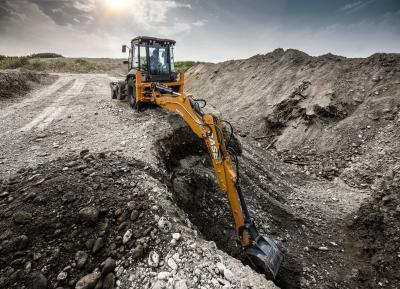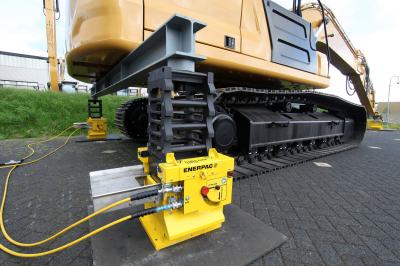Construction machinery was among the top five most financed equipment, along with transportation, agriculture, IT and industry/manufacturing, in 2022.
The equipment finance picture is encouraging, six months after a report indicated it would be a so-so year. The Equipment Leasing and Finance Association (ELFA) reports that June new business volume was up 6 percent year-over-year. That's an excellent indicator of a healthy construction industry, one of the leading big-ticket financing sectors.
The association's Monthly Leasing and Finance Index (MLFI) shows overall new business volume for June was $10.9 billion. Volume was up 15 percent from $9.5 billion in May. Year-to-date, cumulative new business volume was up 1.9 percent compared to 2022. The ELF Foundation's Monthly Confidence Index in July, at 46.4, marks an increase from the June index of 44.1.
"The second quarter concludes on an optimistic note," said Ralph Petta, ELFA president.
Respondents reported strong business performance coupled with a positive outlook for the short-term future of the industry, he added. "As inflation continues to decelerate, the equipment finance market enters the second half of the year in fine shape."
Anthony Sasso, with TD Equipment Finance, believes the equipment finance industry has stayed strong.
"The industry has remained resilient through one of the most turbulent periods in recent economic history," said Sasso. "Despite economic headwinds, like high interest rates, the sector continues to see opportunities for growth and innovation."
He said the year-over-year increase in overall new business volume is consistent with what his company has seen.
"Customers across many sectors continue to look for financing solutions to help them acquire equipment to keep up with demand."
Banner Year in Finance
In fact, ELFA reported in July that new business increased more than 6.5 percent last year. The association's Survey of Equipment Finance Activity (SEFA) saw a higher increase of 7.4 percent in 2021. The annual survey found that after the pandemic rebound, 75 percent of survey respondents saw an increase in volume in 2022.
Federal reserve interest rate hikes caused the cost of funds to jump 211 basis points over the year.
"Managing this cost increase will be a major emphasis as finance companies make their way through the higher interest rate climate," noted the association.
Construction machinery was among the top five most financed equipment, along with transportation, agriculture, IT and industry/manufacturing. The construction sector was among the top five end-user industries contributing the largest share of new business, as well.
The survey found that credit approvals increased year over year, but the percentage of booked approvals declined slightly.
ELFA reports that the number of applications dropped but the dollar volume increased, a symptom of inflation. Reporting on its 2023 construction industry forecast, Wells Fargo noted "cautious optimism" from nonresidential contractors and distributors.
Top concerns include the availability of skilled workers, rising interest rates, economic uncertainty and supply chain disruptions.
Despite the economic challenges of 2022, the non-residential construction industry maintains a hopeful long-term outlook for 2023.
"Economic uncertainty and increasing interest rates are two primary concerns for construction executives," said James Heron, Wells Fargo Equipment Finance Construction Group. "Despite market variables, the optimism reflected confirms industry leaders maintain a deep-seated belief in economic recovery."
Cautious Optimism Rules
The economic environment has caused a divide in perspective and expectation among executives, according to the survey. Those who feel that non-residential construction will remain at current levels also expect activity will begin to increase in 2024 or later.
"However, those who do not believe non-residential construction will remain at current levels foresee a decrease in 2023."
Among top risks, concerns and opportunities, executives are concerned about workforce, the economy, interest rates and the supply chain.
"Inflation has impacted more than 82 percent of surveyed businesses," reports Wells Fargo. "Increased material cost has impacted profitability for more than 59 percent of businesses surveyed."
More than 50 percent of contractors expect to rent heavy equipment at the same pace. The survey found that equipment purchases will be contingent on a stronger backlog of jobs and lower costs. Distributors report continuing to rent the same or more equipment now than a year ago and continue to utilize 70 percent of their fleet.
Equipment Financing 101
Thinking of growing your fleet? There are basics you should know about financing or leasing when you're ready for your next purchase.
The financing process may be easier than you think, according to construction materials supplier White Cap.
"Financing provides construction companies the opportunity to acquire equipment when paying outright is not an option," said Randy Hall of the company's resource center.
Depending on your credit, 100 percent loaning financing may be an option. Otherwise, you may have to make a down payment. As with leasing a vehicle, you pay monthly and at the end of the lease period, you either pay the remaining balance or end your lease. Either way, it's an ideal path to acquiring the equipment you need for your job without the upfront costs, said Hall.
"In today's uncertain economy, borrowing the money to pay for equipment helps keep your cash on hand and available when needed."
He noted there is a difference between heavy equipment loans and regular equipment financing. For larger loans, some lenders will look at your credit score, business cash flow and the amount of your potential down payment.
General rules indicate that if you have been in business for at least one year and have decent credit, you will qualify for a loan. With less than decent credit, you may have to provide a down payment and will likely pay a higher interest rate.
"However, equipment loans are not hard to qualify for, and the equipment itself acts as collateral," said Hall.
If leasing is your preference, you can get new equipment for a period of time and pay monthly. At the end of the lease, you must purchase the equipment, renew your lease (perhaps with an even newer model), or return the machinery.
"You are essentially renting your equipment," said Hall. "Leasing is a good option if the equipment you seek becomes outdated or obsolete quickly."
It's a practical choice, too, if you only need the equipment for a particular timeframe or specific long-term job.
Banks offer these loans, as do online lenders, and the process for each is different. It is recommended you shop around for good rates.
The lender will set the repayment terms and interest rates, Hall said, and generally, rates range from 8 percent to 30 percent.
In terms of tax deductions, the IRS allows businesses to deduct the full purchase price of qualifying equipment financed during the tax year.
So, "if you buy or lease equipment, large or small, you can deduct the full purchase price from your gross income in the first year."
You can instead choose to deduct a certain portion up front and depreciate the balance over subsequent years, he said.
"Remarkably, it is one of the few small business incentives from the federal government."
If your business does not qualify for the Section 179 deduction, you still have options. You may write off the loan or lease payments as a business expense or depreciate the equipment on your taxes, said Hall.
"One the biggest misconceptions is that leasing or financing your equipment excludes you from tax savings," he added.
However, using a $1 purchase option lease or an agreement allowing installments over several years, you can deduct 100 percent of the purchase price in the tax year in which the equipment begins service.
"Always be sure to consult your tax adviser to determine if you qualify for tax breaks," said Hall.
Hall's five best tips for financing construction equipment start with identifying your equipment needs.
"If a piece of equipment will accelerate the pace of your project or benefit your business in the long run, but you can't afford to pay for it, consider a loan."
Second, understand your financing options. One option is to lease the equipment and pay it off at the end of the lease or upgrade to a newer model.
You may opt instead to pull the trigger and make the purchase. "Many loans don't even require adown payment," said Hall.
Number three, know the financing terms, including collateral, term length and interest rates. For instance, the lender often uses the equipment itself as the collateral. They'll take back the equipment if you default on the loan. Term lengths vary depending on the lender, and interest rates are dependent on your credit history.
Fourth, determine your best option. If you want new equipment every few years, said Hall, leasing might be the right scenario for you.
"You can renew your lease and get into something newer. Of course, most heavy-duty equipment is built to last."
That's why if you decided to purchase something you can use on jobs over time, it's best to consider the loan route.
"After you finish making your monthly payments, that's your equipment," said Hall.
Finally, rule number five is to use the IRS's Section 179 Deduction to deduct the full purchase price of the equipment during the first year. CEG
Today's top stories






















